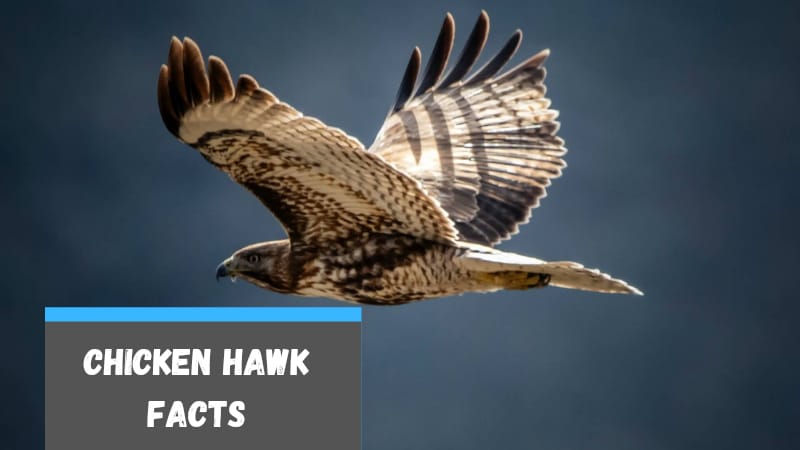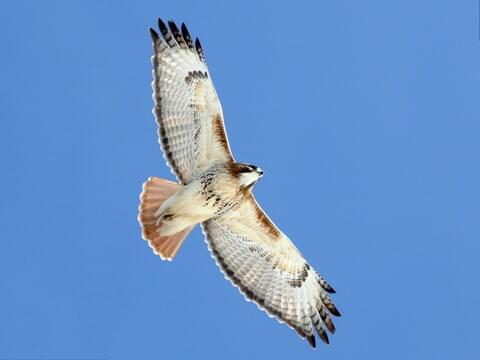
Do you love hawks? Most bird lovers are fond of these powerful birds. Their sharp eyesight and beautiful feathered wings make them so special. We have collected some fantastic Chicken Hawk Bird Facts for you in this article.
So, let us get started!
17 Chicken Hawk Bird Facts
1. Chickenhawk does not mean a single bird. Three species, Cooper’s Hawk, Sharp-Shinned Hawk, and RedHawks, have been labeled as chicken Hawks. All of these are natives of Northern America.
2. These birds are basically predators. They hunt for their prey. Mostly smaller mammals like rabbits and rodents make up primarily for their lunch and dinner! Some other creatures also attract their attention. For example, they may gorge on lizards, squirrels, small snakes, frogs, etc.
3. Hawks are mistaken for being harmful to human beings. Some people believe that occasionally, hawks satisfy their gluttony with poultry birds. But that is not true. Their meal is essentially filled with small mammals and other pests.
4. Since hawks or chicken hawks are predatory species, they have quite a lot of techniques to catch their prey. One of their favorite techniques is to chase their prey while running for escape.
5. The birds of these three species can be spotted in Mexico, the USA, and Canada. Some of them can also be found in southern America. Chicken Hawks absolutely love living in temperate forests with open grasslands. Another preferable habitat of them is the woodlands.

6. You must have seen a group of birds flying together in the pinkish light of the setting sun. Well, that does not happen with hawks.
Chicken Hawks, or the three species labeled as the same, are solitary. They do not fly in groups and can prove to be very hostile to any other bird that enters the limits. However, one may spot the male and the female hawks flying together when it is time for reproduction or when they are mating.
7. Talon makes the hawks most potent. The most powerful weapon of a hawk is its talon. It is firm for gripping any smaller animal, for that matter. Hence, they use this to prey.
8. The Chicken Hawks are notable for their physical highlights. Every one of the three sorts has snared bills. The heads of the Cooper’s Hawks are kind of square in shape. They have long tails formed like a wedge. Their legs and hooks are long and thick. Their bills are sharp. Almost all kinds of Chicken Hawks have longer tails compared to their bodies.
9. The Red-Tailed Hawks are different from the traditional ones when it comes to physical appearance. As the name suggests, the Red-Tailed ones are blessed with red tails. These birds have shorter bills and smaller heads compared to their muscular bodies.
10. The smallest variant among all three is the sharp-shinned Hawk. They have a variety of color combinations. You may spot them in blue-gray, brown-gray, or tawny-gray colors. Also, their plumage colors tend to change after molting.

11. The reproduction process of Chicken Hawks is quite interesting. While the female birds are of the quiet sort for the rest of the year, they make a mating call during the breeding season. The female birds are monogamous.
After the sky dance (the time when the male and the female bird fly together) and mating, both the birds find an appropriate place to build a nest. And after thirty to forty days, the mama bird lays eggs.
In all three kinds of chicken hawks, it has been noticed that a female bird lays four to five eggs on average. But the count does not go higher than eight eggs.
12. Adult male Cooper’s hawks can differ from 35-46 cm, while females develop between 42-50 cm. Their wingspans are 60 to 100 cm. They have an average wingspan of 84 cm. Male birds weigh around 302-402 grams, while females weigh from 479 to 678 grams.
13. The Red-tailed Hawk is the largest among the three. It generally weighs between 690 to 1600 grams. The female red hawks are 1/3 larger than their male counterparts. The wingspan of this species can reach up to 141 cm.
14. Sharp-shinned birds are the tiniest among the three species, as mentioned earlier. Male hawks of this kind are around 25 to 30 cm long. Females measure between 29 to 37 cm. The males have a 40 to 58 cm wingspan and weigh between 82 to 115 grams. Females have a wingspan of around 55 to 68 cm and weigh up to 219 grams.
15. The average lifespan of chicken hawks is somewhere between three to eight years. However, Red-tailed Hawks and Cooper’s Hawks are known to have a lifespan of twenty years in the wild. Long-lived bird indeed!

16. These three species can be differentiated by looking at their eggs as well. The Cooper’s Hawks lay eggs that are white to pale sky-bluish in color. The eggs can have a smooth or a spotted surface.
In the latter, the patches are generally brown. The eggs of the Red-tailed hawks are also white. But they often come with blotches or patches of purple, brown, reddish-brown color. Lastly, the sharp-shinned hawks lay bluish-white eggs and have patches of brown.
17. After the female Hawk lays eggs, the hatchlings are expected within two to four days. Once the eggs are hatched, the baby hawks come out of the shells. At this time, they wear a pale tan pink color.
The growth, in the beginning, is relatively slow. Afterward, they grow rapidly. In the initial three to six weeks, the mama bird happens to take care of the baby birds and teaches them to fly. On the other hand, the male birds go to fetch food.
Once they learn flapping and flying, they become independent.
Conclusion:
The Chicken Hawks, surprisingly, are not fond of chickens! That is a misconception. But more on that later!
These birds are one of the most exciting species in the world. They are generally quiet but have distinctive cries for different purposes. The birds love clean nests. All the blood and leftovers from prey are cleaned regularly.
To be specific, even the chicks in the nest develop to poop outside the nest or on the edge. Likewise, the parent birds do the same. This keeps up with the homes and permits them to stay clean.
We hope you enjoyed learning about Chicken Hawk Bird Facts from this article.
